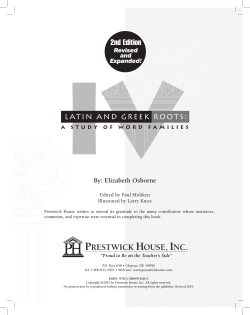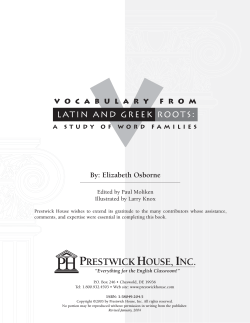
Level 5—Shurley English—Homeschool Edition SCV SCS
Level 5—Shurley English—Homeschool Edition Reference 38: Simple Sentences, Compound Parts, and Fragments Example 1: The little girl looked shyly at her teacher. (S) Example 2: Carla’s mom and dad attended her graduation. (SCS) Example 3: Jennifer jumped and twirled during the dance rehearsal. (SCV) Part 2: Identify each kind of sentence by writing the abbreviation in the blank. (S, SS, F, SCS, SCV) SCV SCS F S SS 1. 2. 3. 4. 5. The children ran and shouted during recess. The rain and sleet fell steadily. During the picnic at noon in the park. Our electricity went off during the ice storm. I watched a movie. It was good. Part 3: Put a slash to separate each run-on sentence below. Then, correct the run-on sentences by rewriting them as indicated by the labels in parentheses at the end of each sentence. 1. The wasps were swarming / they were upset. (SS) The wasps were swarming. They were upset. 2. The horse is in the barn / the cow is in the barn. (SCS) The horse and cow are in the barn. 3. The ambulance parked / it waited for a call. (SCV) The ambulance parked and waited for a call. Reference 39: The Compound Sentence 1. Compound means two. A compound sentence is two complete sentences joined together correctly. y p Co 2. The first way to join two sentences to make a compound sentence is to use a comma and a conjunction. The formula for you to follow will always be given at the end of the sentence. The formula gives the abbreviation for “compound sentence” and lists the conjunction to use (CD, but). Remember to place the comma BEFORE the conjunction. e l p am Example: She studied for her driver’s test, but she did not pass it. (CD, but) 3. The second way to join two sentences and make a compound sentence is to use a semicolon and a connective (conjunctive) adverb. The formula to follow is given at the end of the sentence. The formula gives the abbreviation for “compound sentence” and lists the connective adverb to use (CD; however,). Remember to place a semicolon BEFORE the connective adverb and a comma AFTER the connective adverb. Example: She studied for her driver’s test; however, she did not pass it. (CD; however,) S 4. The third way to join two sentences and make a compound sentence is to use a semicolon only. The formula to follow is given at the end of the sentence and lists the semicolon after the abbreviation for “compound sentence” (CD;). Remember, there is no conjunction or connective adverb when the semicolon is used alone. Example: She studied for her driver’s test; she did not pass it. (CD;) 5. Compound sentences should be closely related in thought and importance. Correct: She studied for her driver’s test, but she did not pass it. Incorrect: She studied for her driver’s test, but she preferred toast. Reference 40: Coordinate Conjunction and Connective Adverb Chart Type of Conj / Adv More Information Contrast/Choice Alternative As a result Coordinate Conjunction ,and ,nor ,but ,yet ,or Connective Adverbs ;moreover, ;furthermore, ;besides, ;also, ;likewise, ;however, ;nevertheless, ;otherwise, Page 30 - Reference Section ,so (as a result) so (that) - no comma ;therefore, ;hence, ;thus, ;consequently, ;accordingly, Level 5 Homeschool Student Book © SHURLEY INSTRUCTIONAL MATERIALS, INC. Level 5—Shurley English—Homeschool Edition Chapter 5 Test Exercise 1: Classify each sentence. 1. After the game, the spectators 2. The fascinated child 3. Eight mighty Olympians quickly moved rushed dashed onto the the drifting toward the for briskly basketball court. bubbles. finish line! Exercise 2: Use Sentence 3 to underline the complete subject once and the complete predicate twice and to complete the table below. List the Noun Used List the Noun Singular or Common or Simple Subject Simple Predicate Job Plural Proper 1. 2. 3. 4. 7. 8. 9. 10. 5. 6. Exercise 3: Name the five parts of speech that you have studied so far. 1. 2. 3. 4. 5. y p Co Exercise 4: Identify each pair of words as synonyms or antonyms by putting parentheses ( ) around syn or ant. 1. authentic, false syn ant 5. ramble, coherent syn ant 2. frugal, thrifty syn ant 6. conceal, exhume syn syn ant 10. construction, dilapidation syn ant 3. fraud, deception syn ant 7. hateful, odious syn ant 11. mimic, imitate syn ant 4. destroy, abolish syn ant 8. pardon, amnesty syn ant 12. melodramatic, subdued syn ant e l p m Sa ant 9. alliance, division Exercise 5: For each sentence, write the subject, then write S if the subject is singular or P if the subject is plural, write the rule number, and underline the correct verb in the sentence. Rule 1: A singular subject must use a singular verb form that ends in s: is, was, has, does, or verbs ending with s or es. Rule 2: A plural subject, a compound subject, or the subject YOU must use a plural verb form that has no s ending: are, were, do, have, or verbs without s or es endings. (A plural verb form is also called the plain form.) Subject S or P Rule 1. 2. 3. 4. 5. 6. 7. 8. 9. 10. Jessica and Jason (talk, talks) on the phone for hours. The keys (was, were) locked in the car. The boys (runs, run) to catch the frisbee. Our parents (was, were) talking about the plans. My car (look, looks) very dirty. Your toothbrush and comb (is, are) in my drawer. The kitten (was, were) licking its paws. (Was, Were) Mom pleased with your grade? Gloria and Wendi (is, are) going to the mall. The company (has, have) many good employees. Exercise 6: In your journal, write a paragraph summarizing what you have learned this week. Page 86 - Test Section Level 5 Homeschool Student Book © SHURLEY INSTRUCTIONAL MATERIALS, INC.
© Copyright 2025





















